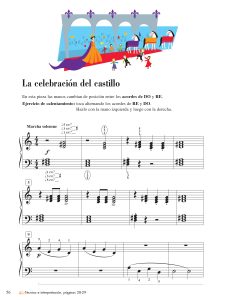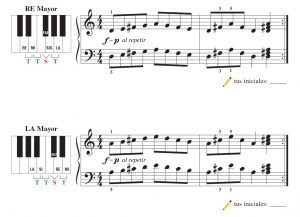Five-Finger Scales and Pattern Recognition
Pattern Recognition
Why are five-finger positions a necessary part of piano pedagogy? Because our hands have five fingers. So the relevance of five-finger patterns applies at virtually any level of piano playing.
Major and minor five-finger patterns are taught in Level 3 (Spanish Edition) of Piano Adventures® after the basics of reading are acquired in the first two levels. With fundamentals of note recognition and intervallic reading firmly in place, this multi-key approach can take hold without liability. After students learn the basics of reading, we can use five-finger positions to enhance reading skill by electing visual, kinesthetic, and aural pattern recognition.
Contour and Context
A student who reads only note-by-note misses the musical picture. Why? Because music is coded in contour and context. Contour of musical line depicts phrasing and the expressiveness of changing pitch. Contour is decoded through recognition of pitch direction and interval.
Context suggests another level of pattern recognition. Context provides harmonic meaning through recognition of chords, key, tonic/dominant relationships, and so on. Context provides artistic meaning through recognition of form and motivic relationships, as well as more subtle relationships found through conscientious study of the score.
From the standpoint of artistry, understanding of contour and context can reduce a dense score to relative simplicity, and thus provide musical meaning that leads to expressive playing. From the standpoint of reading skill, an ability to grasp contour and context simplifies the reading process by allowing visual information to be processed in “chunks” through recognition of familiar patterns.
Piano Adventures® systematically builds skill in pattern recognition using these musical concepts:
- Level 1 introduces steps and skips and Level 2 introduces intervals–2nd, 3rd, 4th, 5th, octave.
- Level 2 introduces five-finger tonality in C and G, with emphasis on tonic and dominant scale steps.
- Level 3 addresses multi-key playing with transposition to C, G, D, A, and their minor five-finger patterns..
- Level 4 added meaning to triad recognition with new awareness of key, key signature, the full major scale in the keys of C, G, and F, and recognition of primary chord functions– I, IV y V7.
- Level 5 introduces the 7th, and pattern recognition with new concepts such as the Alberti Bass, triplets, and rhythm patterns in 3⁄8 and 6⁄8. It also introduces chord inversions, motive and sequence, minor tonalities, and 16th notes
- Level 6 reinforces these major/minor key patterns with special focus on the V7 chord in root position, more work with chord inversions, and expansion of 16th note rhythms. New flat-key patterns and recognition of I, IV, and V chords in any inversion and in any key.
Intervallic Recognition
Decoding contour requires recognition of direction (up, down, same) and interval span (step, skip, fourth, fifth, and so on). This reading skill is not a substitute for note recognition, but a skill to be learned concurrent with note-naming. For this reason, Level 1 merges note name recognition with intervallic/directional reading. These skills go hand in hand.
Note-name recognition is essential for student confidence. Yet, directional/intervallic reading is not of secondary importance. It is essential for grasping music contour and for fluent sight-reading. Intervallic reading is pattern recognition in its most elemental form, and rests on a foundation of note recognition.
Five-Finger Scales
The importance of major and minor five-finger patterns may be obvious, but let’s cite three reasons:
- Major and minor five-finger patterns (pentacles) reinforce recognition of major and minor triads..
- Major and minor five-finger patterns prepare the student for major and minor scales.
- Major and minor five-finger patterns highlight the tonic and dominant notes.
Because five-finger patterns lie stepwise under the hand, this context is ideal for reinforcement of intervallic reading and for transposition. Many pieces at Levels 2 and 3 require moving the hand between familiar positions. This movement between positions sharpens the student’s reading, mitigates position dependence, and invites motion that can prevent a locked wrist.

Notice the shifts between D and C major chords.
(Lesson &Theory, p. 56)
Three modalities underlie recognition of five-finger patterns:
- Staff recognition is visual.
- Keyboard topography is kinesthetic.
- Aural perception of five-note tonality is auditory.
The use of five-finger scales provides a playing field for the integration of these three modalities – visual, kinesthetic, and auditory. Occasionally, it’s helpful to spotlight a specific modality. For instance, the shift from major to minor (or vice versa) is aurally striking.
Introduce five-finger patterns through visual contrast of white and black keys. Stress the feel of the pattern. The pairing of D and A Major highlights both their visual and kinesthetic similarities.

(Technique & Performance, p. 43)
Rhythmic “Chunking”
Eighth notes are not presented in Piano Adventures® until Level 3. This allows the student to be confident with rhythm first. Without quavers, the beat can be quite fluid and fast instead of a slow, stodgy beat. Teachers readily recognize the increase in rhythmic flow and musicality.
![]()
When eighth notes are introduced at the beginning of Level 3, they are presented in rhythmic groupings.
Thus the student is led to read eighth notes not as individual counted or sub-sounds, but as meaningful rhythmic patterns that are felt kinesthetically.
Summary
Repetition of predictable patterns leads to quick recognition of these patterns. We can’t assume that random occurrence of principal patterns will lead to recognition. Instead, equip students with tools of pattern recognition through systematic presentation of patterns and a matching repertoire.
Through transposition, “question and answer,” harmonization, ear training, and a carefully conceived repertoire, five-finger patterns lay a foundation of pattern recognition leading to intelligent, fluent music reading.

